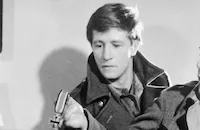The Password Is Courage

Brief Synopsis
Cast & Crew
Andrew L. Stone
Dirk Bogarde
Maria Perschy
Alfred Lynch
Nigel Stock
Reginald Beckwith
Film Details
Technical Specs

Synopsis
While being marched to a German prisoner-of-war camp in World War II, British Sgt. Maj. Charles Coward escapes by lying down with wounded German soldiers. He is taken to a German hospital and decorated with the Iron Cross before his true identity is discovered. Transferred to prison camp, Coward immediately begins making plans for a tunnel escape. Through a ruse, he is able to get an afternoon pass into the neighboring town, where he contacts a member of the Polish underground, Irena, who gives him the necessary maps and escape information. Back in camp, he completes the tunnel and escapes with his friend Billy Pope, only to be recaptured in Vienna. Near the end of the war, Coward and Pope steal a fire engine and make a successful lunge to freedom through enemy villages.

Director

Andrew L. Stone
Cast

Dirk Bogarde
Maria Perschy

Alfred Lynch

Nigel Stock
Reginald Beckwith
Richard Marner
Ed Devereaux
Lewis Flander
George Mikell
Richard Carpenter
Margaret Whiting
Olaf Pooley
Ferdy Mayne

Colin Blakely
Michael Mellinger
Bernard Archard
George Pravda

Mark Eden
Douglas Livingstone
John Gardiner
Howard Pays
Tommy Elliott
Bernard Proctor
Philo Hauser
Crew
Noreen Ackland
Wilfred Arnold
Davis Boulton
British Railways
Charles Coward
Alma Godfrey
Great Britain--war Office
Irene Howard
Joan Kirk
Derek New
Henri Pieck
George Pollard
Tommy Riley
Tommy Riley
J. B. Smith
Larry Stewart
Andrew L. Stone
Andrew L. Stone
Christopher Stone
Virgina Stone
Virginia Stone
Virginia Stone
Sydney Streeter
Cyril Swern
Bill Warrington
A. W. Watkins

Film Details
Technical Specs

Articles
The Password is Courage
But more importantly, he created small irritations and, when possible, carried out larger-scale acts of sabotage against the Germans. He damaged millions of marks' worth of German equipment, brazenly saved lives at Auschwitz by substituting dead men for live ones, sent word back to England of the coming blitz, and after the war testified at the Nuremburg trials. At one point his fluent German allowed him to pose as a wounded solider in a German field hospital, and he was awarded the German Iron Cross.
In 1954, author John Castle published a book about Coward's exploits entitled The Password Is Courage. It was optioned by the husband-and-wife producers Andrew and Virginia Stone (Andrew also wrote and directed the film, and Virginia was supervising editor), who had a reputation for shooting their films on location and with high degrees of realism. For this picture, plans to shoot on the European continent fell through, and they shot instead in the towns and countryside of England.
For a spectacular train wreck sequence, the company bought a British Railways locomotive that was due to be retired. They disguised it with smoke deflectors and iron crosses, sent it up a 40-foot hill at 30mph, then derailed it and sent it plunging down an embankment, all in front of five cameras. The Stones also built a German "stalag" in Eppings Forest outside of London; used a real, defunct, military hospital for hospital scenes; bought forty assorted trucks, twenty to be blown up and the rest to be hurled off a cliff; and purchased an old lumber mill that they could burn to the ground.
In the mill sequence, Coward (played in the film by Dirk Bogarde) and his men burn it down as sabotage, then convince a German officer that it happened because the officer was smoking on duty. Coward tells the officer that he won't report the incident if he gets to spend the afternoon off, without a guard, at a nearby town.
Apparently these incidents all actually happened, and Coward himself served as the film's technical advisor to ensure authenticity. That said, there has been some speculation in the years since Coward's death that his tales were exaggerated to some degree. But in any case, the movie stands as an entertaining, if lighthearted, account of one man's skill at consistently outwitting his captors, a man whom Andrew and Virginia Stone described as "a Scarlet Pimpernel character."
Audiences and critics liked The Password Is Courage, though some eyebrows were raised at the inclusion of the Auschwitz sequence in what is essentially a light film. The New York Times declared the movie to be "a lively, catchy show" and The Hollywood Reporter decreed, "The picture moves along, it has legitimate humor in essentially grim circumstances, and is highlighted by the spectacular action sequences the Stones have made their hallmark." Another trade paper, Variety, said the movie "lacks conviction" and thought it all came across "more like reel life than real life." The review added, "Bogarde gives a performance that is never less than competent, but never much more."
By Jeremy Arnold

The Password is Courage
Quotes
Trivia
Notes
Opened in London in October 1962.

Miscellaneous Notes
Released in United States 1962
Released in United States 1962














